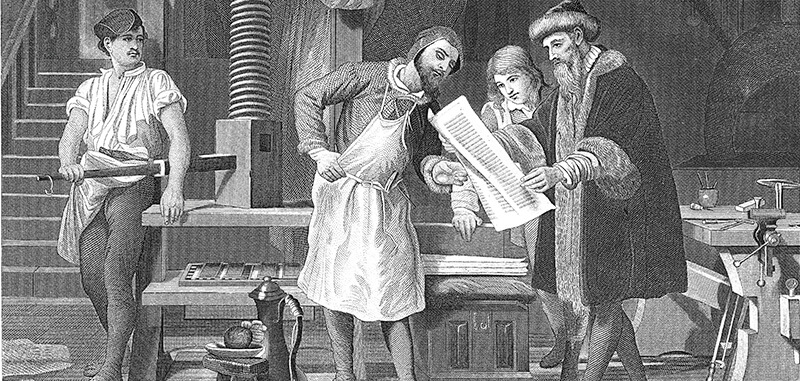
Ask anyone in the western world what they know about the history of printing, and it’s a sure bet that – if they know anything at all – they’ll start with Johannes Gutenberg. In Europe and North America, Gutenberg’s name is not only synonymous with the early history of the printing press, but the information revolution it sparked.
Gutenberg’s innovations ushered in an era of mass communication and the dissemination of written material throughout all levels of European society. As a result, he’s considered one of the most consequential figures in history, a progenitor of the Renaissance, the Reformation, and the modern world.
As we continue our series on the history of printing presses, we want to dedicate today’s entry to the man who – in Europe, anyway – started it all.
Who Was Johannes Gutenberg?
Johannes Gutenberg was a German inventor (among many other things) who lived from roughly 1400 to 1468. Born in Mainz, he came from a family of wealthy elite and eventually took up residence in Strasbourg (which is now in France).
The scant records we have about Gutenberg’s life in Strasbourg come from legal disputes he had with his partners. He seems to have been a bit of a hustler, always on the lookout for new ways of making money. He worked on a new method for polishing gemstones and made mirrors to sell to religious pilgrims. (The mirrors were meant to capture holy light from sacred relics.)
Gutenberg may have begun experimenting with the techniques he incorporated into his printing press while he was in Strasbourg, but his work didn’t come to fruition until after a move back to Mainz.
Did Gutenberg Invent the Printing Press?
It depends on what you mean by “invent” and “printing press.” As we covered in our last history installment, the Chinese were printing using woodblocks as far back as the ninth century A.D. An inventor named Bi Sheng came up with moveable type in 1088, and over the next few centuries, Chinese artisans experimented with wood, metal, and clay type.
It’s not clear how much – if any – Asian printing technology influenced Gutenberg’s work. Before Gutenberg, books in Europe were written out by hand, usually by monks. As each book represented innumerable hours of painstaking labor, books were expensive in the middle ages. Ordinary people did not own books, and most couldn’t read.
Europeans were not ignorant of the basic concepts of printing, however. Woodblock printing was used throughout Europe for items like playing cards, posters, and paper money.
What Did Gutenberg Do?
Gutenberg is responsible for several technological innovations which, together, coalesced into a system that made printing reliable, relatively inexpensive, and feasible on a large scale. He didn’t necessarily invent anything new, but he refined existing processes and tools and applied them to printing.
We don’t know much about Gutenberg’s thought process, or the failures he may have experienced on the way to success, but we do know his press was up and running sometime around 1450. The most notable features of Gutenberg’s system were:
- The use of moveable metal type (individual character blocks that can be rearranged and reused to compose a text). Gutenberg’s “special sauce” for type metal was a mixture of lead, tin, and antimony. The combined properties of these metals create an alloy that is durable and easy to cast and recast.
- An adjustable hand mould for casting type quickly and in high volume, allowing for the mass production of moveable type.
- A wooden screw press inspired by wine presses. Paper can be slid in and out of the screw press quickly, allowing for assembly line-style production.
- Oil-based printer’s ink designed to adhere to metal.
What Is the Gutenberg Bible?
The Gutenberg Bible is Gutenberg’s most famous achievement and one of the first books printed in Europe. Gutenberg printed about 180 copies of the 1,300-page book, of which 49 are known to exist today (21 complete).
You can look through an entire digitized copy of the Gutenberg Bible on the website of the British Library.
What Happened After Gutenberg?
Gutenberg was not a particularly successful businessperson, and by 1456 he owed an immense amount of money and had to turn his equipment over to a former partner. Gutenberg died in 1468 and like many geniuses, was unappreciated in his time.
But the printing techniques that Gutenberg pioneered spread rapidly through Europe, propelled by the workers who had helped Gutenberg in his shop. By the 1470s, printing was flourishing in Italy, France, and Spain. The technology reached England in 1476.
We can’t know if Gutenberg foresaw the many ways his inventions would upend society. As printing caught on and the cost of books plummeted, information that had once been tightly controlled by the clergy and nobility began to reach the masses.
Revolutionary thinkers like Luther and Copernicus now had a way to get their ideas past the gatekeepers. Worldviews shifted, and empowered by literacy, a powerful middle class emerged. And it was all thanks to a resourceful German goldsmith who may just have been looking to make a few guilders.
The Journey to Today
Most custom labels today are not printed using the methods Gutenberg perfected. Faster industrial printing technology eclipsed Gutenberg’s letterpress in the 20th century. But the idea that drove Gutenberg – that technology can make printing more efficient, more accurate, and more affordable – still drives printers today.
Modern label printers use technology to help their customers stand out, with brighter colors, crisper text, a wider range of shapes and materials, more durability, and better security features than ever before. To learn about everything today’s label printer has to offer your brand, get your free copy of the Custom Label Buying Guide.

